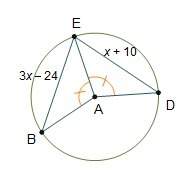
Mathematics, 28.12.2019 01:31 Jcausey4477
The time it takes a planet to go once around the sun (length of year) depends on its distance from the sun (distance from sun). suppose you wanted to test the claim that this relationship is linear. assuming you could get data on planets' distances from the sun and the lengths of their years, which of the following would you have to do before deciding whether to proceed with the hypothesis test? mark all that apply. a. examine a scatterplot, to see whether there is a linear relationship between the two variables distance from sun and length of year. b. examine a q-q plot of the residuals, to see whether the error term (ϵ {"version": "1.1","math": "\epsilon"}) is normally distributed. c. examine a residual plot, to see whether the variance of the error term is the same for all values of length of year. d. examine a residual plot, to see whether the variance of the error term is the same for all values of distance from sun.

Answers: 3


Another question on Mathematics

Mathematics, 21.06.2019 16:30
Ivan and jeff buy a package of 8 pens for $4.00. ivan wants 5 of the pens, and jeff wants 3.how much should each student pay?
Answers: 1

Mathematics, 21.06.2019 18:00
Me, the vertices of quadrilateral coat are c(2,0), o(7,0), a(7,2) and t(2,2). prove that coat is a rectangle.
Answers: 3

Mathematics, 21.06.2019 19:00
Use the quadratic formula to solve the equation. if necessary, round to the nearest hundredth. x^2 - 23 = 10x a. -1.93, 11.93 b. 1.93, -11.93 c. 1.93, 11.93 d. -1.93, -11.93
Answers: 2

Mathematics, 21.06.2019 20:20
Drag the tiles to the correct boxes to complete the pairs. not all tiles will be used. identify the domain for each of the given functions.
Answers: 1
You know the right answer?
The time it takes a planet to go once around the sun (length of year) depends on its distance from t...
Questions

Mathematics, 04.11.2020 16:50

Mathematics, 04.11.2020 16:50


Biology, 04.11.2020 16:50



History, 04.11.2020 16:50

Biology, 04.11.2020 16:50

Mathematics, 04.11.2020 16:50










Social Studies, 04.11.2020 16:50

English, 04.11.2020 16:50





